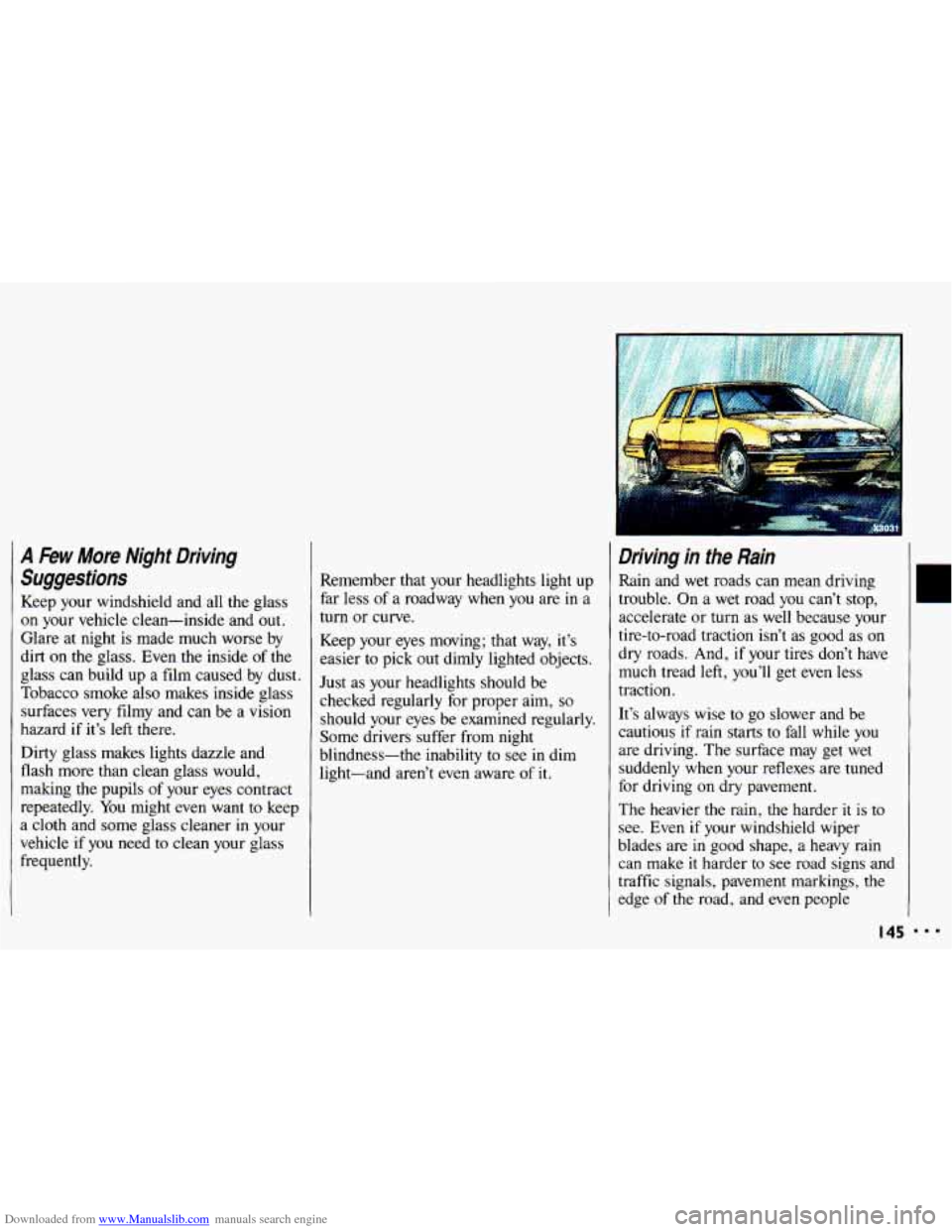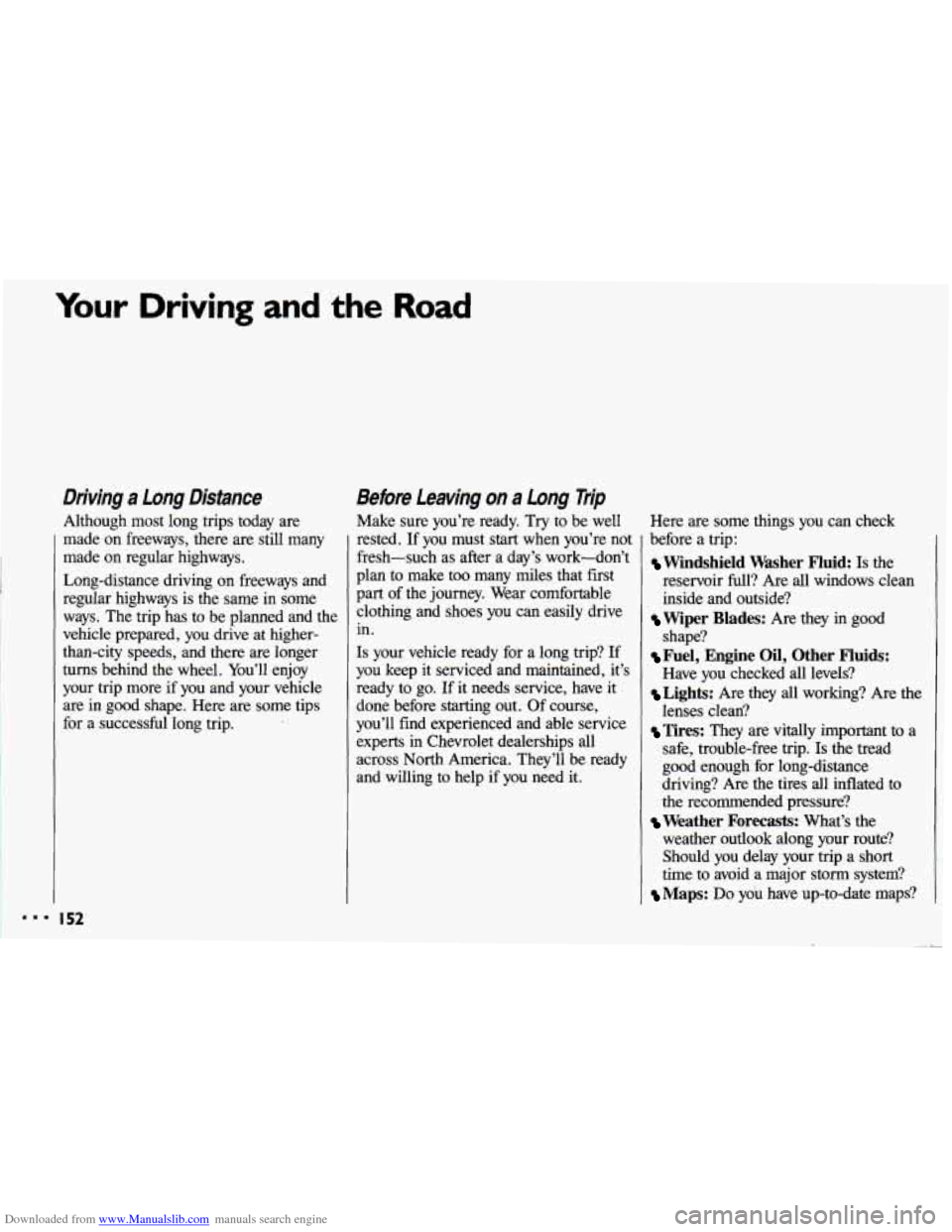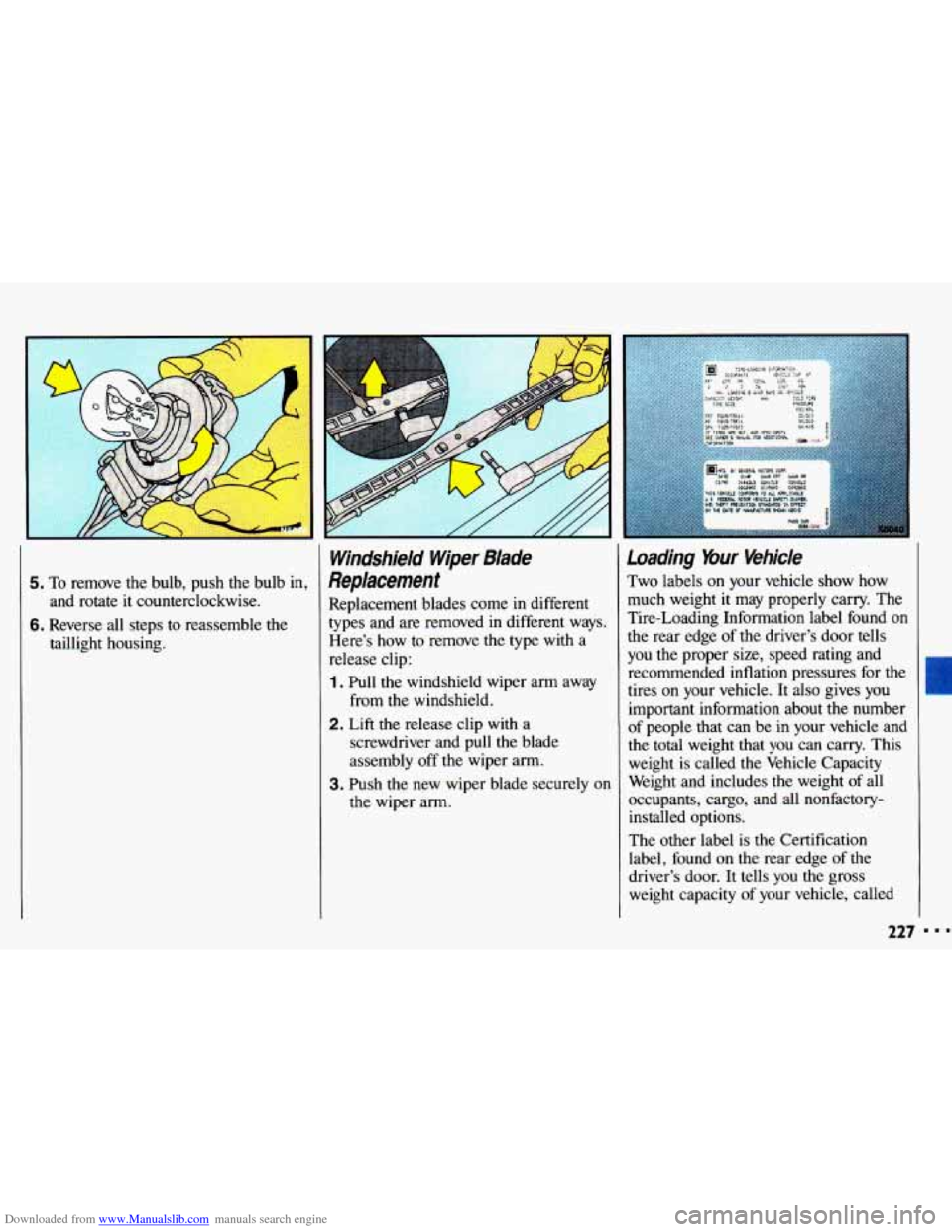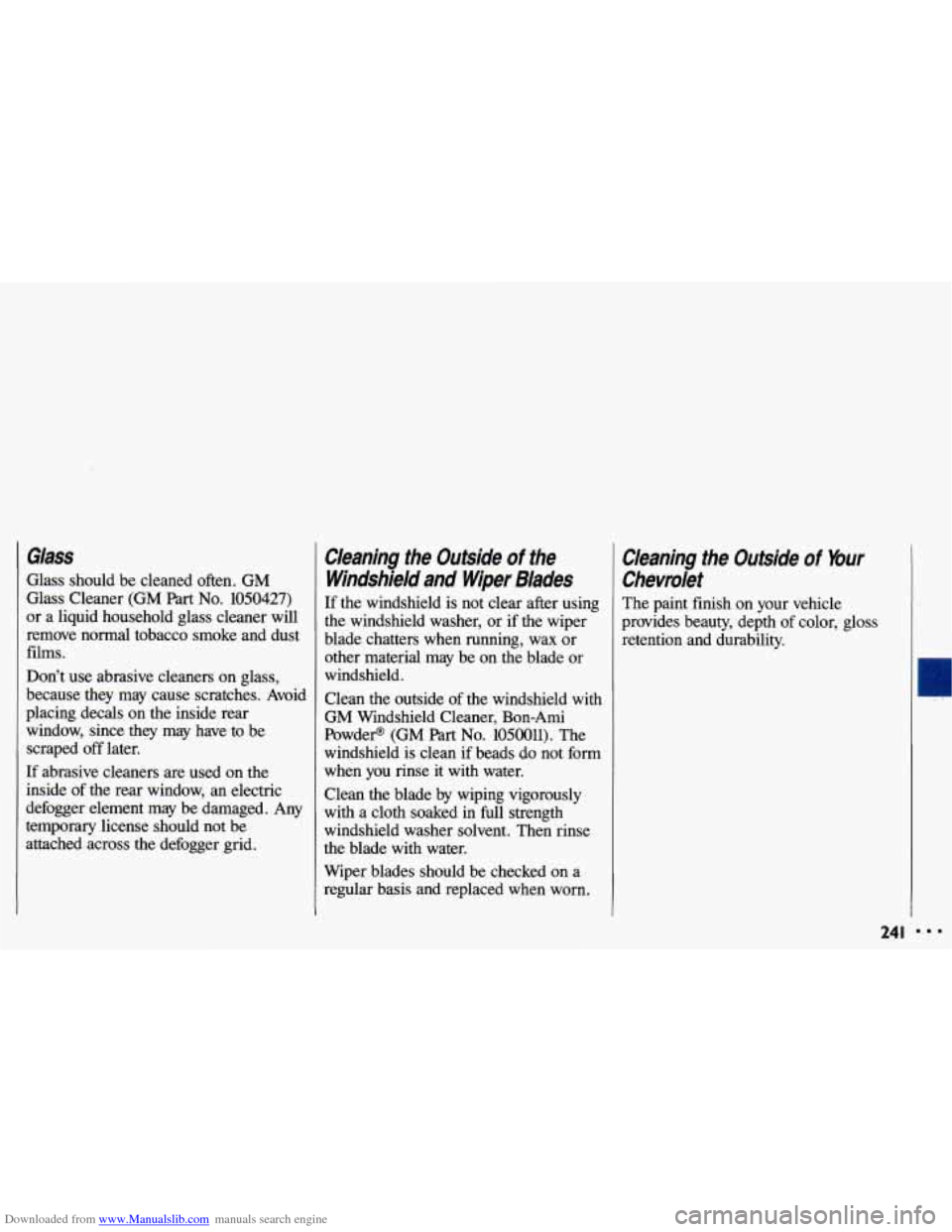1993 CHEVROLET CAVALIER wiper blades
[x] Cancel search: wiper bladesPage 85 of 308

Downloaded from www.Manualslib.com manuals search engine L
Windshield Wipers 1
You control the windshield wipers by
moving
the stalk with the wiper symbol 1 , Damaged wiper blades may
on
it up or down.
For a Single Wiper Cycle:
Push the stalk down to MIST until the
wipers start,
then let go. The wipers will
stop after one cycle. For more cycles,
hold the stalk down on
MIST longer.
For Steady Wiper Cycles:
Move the stalk up to either I (Low) or
I1 (High), depending on the wiper speed
you want.
To Turn Wipers Off
Move the stalk to OFF-
I CIUU I IWIV
5 prevent you from seeing well
enough
to drive safely. To avoid
damage, be sure to clear ice and
snow from
the wiper blades before
using them. If they're frozen to the
windshield, carefully loosen or
thaw them. If your blades do
become damaged, get new blades
or blade inserts.
Heavy snow
or ice can overload your
wipers.
A circuit breaker will stop then
until the motor cools. Clear away snow
or ice to prevent an overload.
Intermittent Windshield Wipers
(OPTION)
If your vehicle has intermittent
windshield wipers, you can set the
wiper speed for a long or short delay
between wipes. This can be very useful
in light rain or snow.
Move the stalk to
DEL, then rotate the
band marked
DELAY to choose the
delay you want. Rotate the band up for
shorter delay times between wiper
cycles. Rotate
the band down for longer
delay times between wiper cycles.
For a single wiper cycle, push the stalk
to
MIST, then let go.
83 mm.
Page 147 of 308

Downloaded from www.Manualslib.com manuals search engine A Few More Night Driving
Suggestions
Keep your windshield and all the glass
on your vehicle clean-inside and out.
Glare at night is made much worse by
dirt
on the glass. Even the inside of the
glass can build up a film caused by dust.
Tobacco smoke also makes inside glass
surfaces
very filmy and can be a vision
hazard
if it's left there.
Dirty glass makes lights dazzle and
flash more than clean glass would,
making the pupils of your eyes contract
repeatedly. You might even want
to keep
a cloth and some glass cleaner in your
vehicle if you need
to clean your glass
frequently. Remember that your headlights light
up
far less of a roadway when you are in a
turn or curve.
Keep your eyes moving; that way, it's
easier to pick out dimly lighted objects.
Just as your headlights should be
checked regularly for proper aim,
so
should your eyes be examined regularly.
Some drivers suffer from night
blindness-the inability to see
in dim
light-and aren't even aware of
it.
Driving in the Rain
Rain and wet roads can mean driving
trouble. On a wet road you can't stop,
accelerate or turn as well because your
tire-to-road traction isn't as good as on
dry roads. And,
if your tires don't have
much tread left, you'll get even less
traction.
It's always wise to go slower and
be
cautious if rain starts to fall while you
are driving. The surface may get wet
suddenly when your reflexes are tuned
for driving on dry pavement.
The heavier the rain, the harder
it is to
see. Even if your windshield wiper
blades are in good shape, a heavy rain
can make
it harder to see road signs and
traffic signals, pavement markings, the
edge
of the road, and even people
IC
I45 ...
Page 154 of 308

Downloaded from www.Manualslib.com manuals search engine Your Driving and the Road
Driving a Long Distance
Although most long trips today are
made on freeways, there are still many
made on regular highways.
Long-distance driving on freeways and
regular highways is the same in some
ways. The trip has to be planned and the
vehicle prepared, you drive at higher-
than-city speeds, and there are longer
turns behind the wheel. You’ll enjoy
your trip more
if you and your vehicle
are in good shape. Here are some tips
for a successful long trip.
Before Leaving on a Long Trip
Make sure you’re ready. Try to be well Here are some things you can check
rested. If you must start when you’re not
fresh-such as after a day’s work-don’t
plan to make too many miles that
first
part of the journey. Wear comfortable
clothing and shoes you can easily drive in.
Is your vehicle ready for a long trip? If
you keep it serviced and maintained, it’s
ready to
go. If it needs service, have it
done before starting out. Of course,
you’ll find experienced and able service experts
in Chevrolet dealerships all
across North America. They’ll be ready
and willing to help if you need it.
I’
before a trip:
Windshield Washer Fluid: Is the
reservoir full? Are all windows clean
inside and outside?
shape?
Have you checked all levels?
lenses clean? safe, trouble-free trip.
Is the tread
good enough for long-distance
driving? Are the tires all inflated to
the recommended pressure?
weather outlook along your route?
Should you delay your trip a short
time to avoid a major storm system?
Maps: Do you have up-to-date maps?
Wiper Blades: Are they in good
Fuel, Engine Oil, Other Fluids:
Lights: Are they all working? Are the
Tires: They are vitally important to a
Weather Forecasts: What’s the
Page 229 of 308

Downloaded from www.Manualslib.com manuals search engine 5. To remove the bulb, push the bulb in,
and rotate it counterclockwise.
6. Reverse all steps to reassemble the
taillight housing.
Windshield Wiper Blade
Replacement
Replacement blades come in different
types and are removed in different ways.
Here’s how
to remove the type with a
release clip:
1. Pull the windshield wiper arm away
2. Lift the release clip with a
from the windshield.
screwdriver and pull the blade
assembly
off the wiper arm.
the wiper arm.
3. Push the new wiper blade securely on
Loading %ur Vehicle
Two labels on your vehicle show how
much weight it may properly carry. The
Tire-Loading Information label found
on
the rear edge of the driver’s door tells
you the proper size, speed rating and
recommended inflation pressures for the
tires on your vehicle. It also gives
you
important information about the number
of people
that can be in your vehicle and
the total weight that you can carry. This
weight
is called the Vehicle Capacity
Weight and includes the weight
of all
occupants, cargo, and all nonfactory- installed options.
The other label
is the Certification
label, found on the rear edge of the
driver’s door. It tells you the gross
weight capacity
of your vehicle, called
I
227
Page 243 of 308

Downloaded from www.Manualslib.com manuals search engine Glass
Glass should be cleaned often. GM
Glass Cleaner (GM
Part No. 1050427)
or a liquid household glass cleaner will
remove normal tobacco smoke and dust
films.
Don’t use abrasive cleaners on glass,
because they may cause scratches. Avoid
placing decals on the inside rear window, since they may have to be
scraped off later.
If abrasive cleaners are used on the
inside of the rear window, an electric
defogger element may be damaged. Any
temporary license should not be
attached across the defogger grid.
Cleaning the Outside of the
Windshield and Wiper Blades
If the windshield is not clear after using
the windshield washer, or if the wiper
blade chatters when running, wax or
other material may be on the blade or
windshield.
Clean the outside
of the windshield with
GM Windshield Cleaner, Bon-Ami
Powder@
(GM Part No. 1050011). The
windshield is clean if beads do not form
when you rinse it with water.
Clean the blade by wiping vigorously
with a cloth soaked in full strength
windshield washer solvent. Then rinse
the blade with water.
Wiper blades should be checked
on a
regular basis and replaced when worn.
Cleaning the Outside of Your
Chevrolet
The paint finish on your vehicle
provides beauty, depth of color, gloss
retention and durability.
I